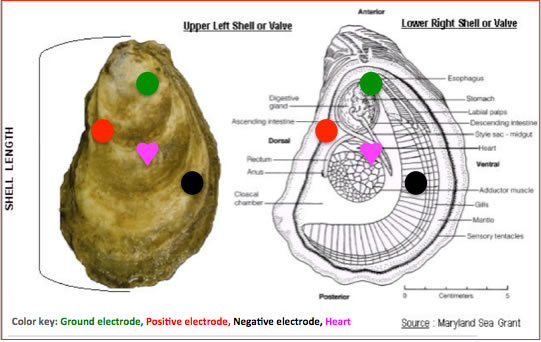The effect of varying environmental conditions on the heart rate of the Eastern oyster (Crassostrea virginica) from the Chesapeake Bay.
The eastern oyster (Crassostrea virginica) is an ecologically and commercially important species in the Chesapeake Bay. It is also a species capable of tolerating a wide range of environmental extremes. Undergraduate student Drew Needham and high school intern Michelle Gray have been investigating how changes in environmental conditions affect the heart rate of the eastern oyster. Specifically, Drew and Michelle are exploring how variation in temperature, salinity and dissolved oxygen affect oyster heart rates. In our lab we are using an electrocardiograph (ECG) to measure heart rate, through the insertion of three minimally invasive probes via small holes drilled in the shell. Below is a diagram of an oyster with ECG probes.

Figure 1. Probe placement diagram. Circles represent probe locations: ground, positive, and negative.
For each experiment described below, oysters were prepared by using a drill press and carbide-tipped drill bit (5/16”), three holes were drilled into the oyster’s shell, corresponding to three ECG probes to be inserted (see picture above). Probes were inserted into the oyster, and a connection to iWorx and computer software was confirmed through visible ECG reading (Figure 2).

Figure 2. Electrocardiograph display image. Each large spike represents an atrial beat of the oyster heart.
Temperature
Temperature trials were conducted during 2012 by Drew Needham. Earlier investigations of temperature and bivalve heart rate suggest a positive correlation between the two, however, such studies involved invasive procedures that may enhance stress and possibly affect heart rate observations (Feng 1965). The heart rate of oysters was measured at three temperatures (5, 15, and 25°C) to determine if temperature had a significant effect on oyster heart rate. The results of the temperature experiment confirm previous observations relating C. virginica heart rate to water temperature, but through a more precise and modern means.
References: Feng SY. (1965). Heart rate and leucocyte circulation in Crassostrea virginica (Gmelin). Biol. Bull. 128:198–210.
Salinity
High school intern Michelle Gray is currently conducting salinity trials to quantify the potential impact of salinity on the heart rate of oysters. Oysters are acclimated to either low (6ppt), normal (15ppt) or high (24ppt) salinity water for at least 4 days prior to experimentation. After the acclimation period, oysters are prepared according to the procedure outlined above and ECG data are collected for a minimum of 6 hours. Average heart rate per oyster is calculated once a consistent heart beat is observed. This study is ongoing, and data are being analyzed to identify potential trends.
Dissolved Oxygen
Drew will be conducting dissolved oxygen trials in the spring of 2013 to determine the impact of dissolved oxygen levels on oyster heart rate. The procedure for these experiments is still being worked out, so stay tuned for more information in the months to come!
For more information on the oyster heart rate studies, please email us at paynteroysterlab@gmail.com!